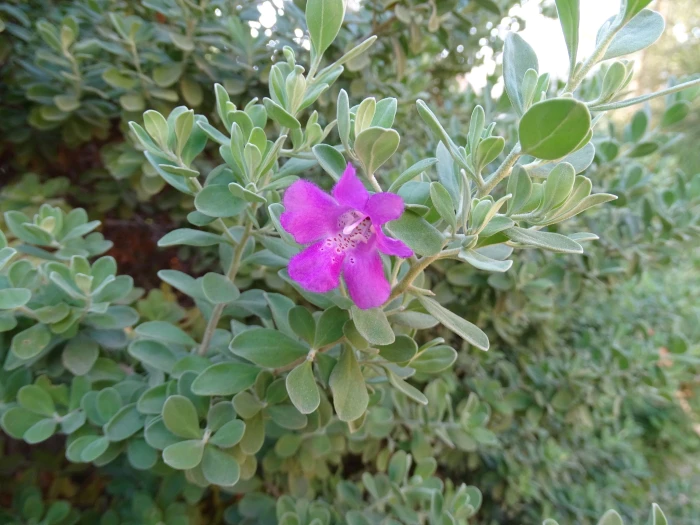Texas Sage
(Leucophyllum frutescens)
Texas Sage (Leucophyllum frutescens)
/
/

© Jacky Judas
CC BY 4.0
Image By:
© Jacky Judas
Recorded By:
Copyright:
CC BY 4.0
Copyright Notice:
Photo by: © Jacky Judas | License Type: CC BY 4.0 | License URL: http://creativecommons.org/licenses/by/4.0/ | Uploader: jackyjudas | Publisher: iNaturalist |













































































Estimated Native Range
Climate Requirements for Ormond Beach, Florida
| This Plant | Your Site | Plant Suitability for Your Location | ||
|---|---|---|---|---|
| • Precipitation | 2" - 110" | 50" | Aquatic | Aquatic |
| • High Temp. | 74°F - 109°F | 90°F | Your summer temperatures are normal for this plant. | Excellent |
| • Low Temp. | 18°F - 78°F | 47°F | Your winter temperatures are normal for this plant | Excellent |
This plant may not grow well at your location - your precipitation is too high.
Summary
Leucophyllum frutescens, commonly known as Texas Sage, is an evergreen or semi-deciduous shrub native to the Chihuahuan Desert and Tamaulipan mezquital ecoregions, which include arid landscapes in Mexico and Texas. It typically grows to a height of 2-5 feet (0.6-1.5 meters) and a similar width. Texas Sage has a dense, compact form with silvery to greenish-gray foliage and is notable for its profuse purple or lavender flowers that bloom from summer to fall, providing a showy display. The flowers are bell- or funnel-shaped, with five lobes and two lips, and they often cover the entire plant when in bloom.
Texas Sage is valued for its drought tolerance and ability to thrive in hot, arid conditions, making it an excellent choice for xeriscaping and water-wise gardens. It is commonly used for edge and area plantings, as well as for creating informal hedges due to its ease of shaping. This species prefers rocky, calcareous soils and requires minimal water once established. It does best in full sun and is tolerant of a range of soil types, provided they have good drainage. While generally low-maintenance, it can be susceptible to root rot if overwatered and may suffer from chlorosis in poorly drained soils.CC BY-SA 4.0
Texas Sage is valued for its drought tolerance and ability to thrive in hot, arid conditions, making it an excellent choice for xeriscaping and water-wise gardens. It is commonly used for edge and area plantings, as well as for creating informal hedges due to its ease of shaping. This species prefers rocky, calcareous soils and requires minimal water once established. It does best in full sun and is tolerant of a range of soil types, provided they have good drainage. While generally low-maintenance, it can be susceptible to root rot if overwatered and may suffer from chlorosis in poorly drained soils.CC BY-SA 4.0
Plant Description
- Plant Type: Shrub
- Height: 5-8 feet
- Width: 4-6 feet
- Growth Rate: Moderate
- Flower Color: Pink, Purple
- Flowering Season: Summer
- Leaf Retention: Evergreen
Growth Requirements
- Sun: Full Sun
- Water: Low
- Drainage: Medium
Common Uses
Bee Garden, Bird Garden, Border Plant, Butterfly Garden, Deer Resistant, Drought Tolerant, Fragrant, Hummingbird Garden, Low Maintenance, Potted Plant, Salt Tolerant, Showy Flowers, Street Planting
Natural Habitat
Chihuahuan Desert and Tamaulipan mezquital ecoregions, with arid landscapes in Mexico and Texas
Other Names
Common Names: Texas Silverleaf, Texas Barometerbush, Purple Sage, Texas Ranger, Texas Rain Sage, Ash Bush, Wild Lilac, Senisa, Cenicilla, Palo Cenizo, Hierba Del Cenizo
Scientific Names: Leucophyllum frutescens, Leucophyllum texanum, Leucophyllum frutescens f. albineum, Leucophyllum frutescens f. albiflorum, Terania frutescens
GBIF Accepted Name: Leucophyllum frutescens (Berl.) I.M.Johnst.